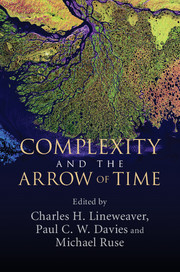Book contents
- Frontmatter
- Contents
- Author biographies
- Part I Introduction
- Part II Cosmological and physical perspectives
- Part III Biological complexity, evolution, and information
- 7 Life: the final frontier for complexity?
- 8 Evolution beyond Newton, Darwin, and entailing law: the origin of complexity in the evolving biosphere
- 9 Emergent order in processes: the interplay of complexity, robustness, correlation, and hierarchy in the biosphere
- 10 The inferential evolution of biological complexity: forgetting nature by learning to nurture
- 11 Information width: a way for the second law to increase complexity
- Part IV Philosophical perspectives
- Index
- References
11 - Information width: a way for the second law to increase complexity
from Part III - Biological complexity, evolution, and information
Published online by Cambridge University Press: 05 July 2013
- Frontmatter
- Contents
- Author biographies
- Part I Introduction
- Part II Cosmological and physical perspectives
- Part III Biological complexity, evolution, and information
- 7 Life: the final frontier for complexity?
- 8 Evolution beyond Newton, Darwin, and entailing law: the origin of complexity in the evolving biosphere
- 9 Emergent order in processes: the interplay of complexity, robustness, correlation, and hierarchy in the biosphere
- 10 The inferential evolution of biological complexity: forgetting nature by learning to nurture
- 11 Information width: a way for the second law to increase complexity
- Part IV Philosophical perspectives
- Index
- References
Summary
RISING COMPLEXITY, NATURAL SELECTION, AND THERMODYNAMICS
It seems that many systems both increase their complexity if initialized in a low complexity state, and then reliably and robustly maintain high (but finite) complexity once it is attained. Some of the most prominent examples are the many biological systems undergoing natural selection that seem to start with low complexity and then increase their complexity (Krakauer, 2011; Carroll, 2001; McShea, 1991; Smith, 1970). Such systems are typically modeled as localized individuals that reproduce in an error-prone process, with their offspring weeded out in competitions with other individuals that select for higher complexity. In this natural selection process the individuals in a line of biological descent increase their complexity in time.
Some have argued from these examples that natural selection is a necessary condition for complexity to increase. The idea is that for a particular lineage to have a large fitness advantage over its competitors, it must become increasingly “complex”. However, we should not confuse the properties of an example of a phenomenon with the phenomenon itself: complexity increase is not synonymous with adaptionist natural selection. Indeed, one can engineer by hand models of systems undergoing natural selection where the competition selects for low complexity of the individuals in a line of descent, not high complexity. One can even engineer models where the competition ends up weeding out all the individuals, so that the natural selection causes all the lines of descent to die – in which case the complexity of the system has been driven to its minimal value. So natural selection, by itself, need not cause complexity to increase.
- Type
- Chapter
- Information
- Complexity and the Arrow of Time , pp. 246 - 276Publisher: Cambridge University PressPrint publication year: 2013
References
- 5
- Cited by



